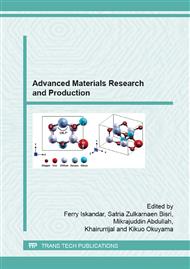p.445
p.449
p.453
p.458
p.462
p.466
p.470
p.474
p.481
Microstructure and Mechanical Properties of Extruded Mg-1.6Gd as Prospective Degradable Implant Materials
Abstract:
Mg-1.6 Gd alloy ingot were prepared by hot extrusion. The extruded alloy exhibits the recrystallised grain size and excellent mechanical properties. The aim of this study is to explore the microstructure and mechanical properties of extruded Mg-1.6 Gd to be used as implant. Extrusion was performed at temperatures of 400°C, 450 °C, 500°C and 550°C with a speed of 1mm/s and extrusion ratio of 30%. Tension and hardness testing were carried out on samples taken from extruded rod of Mg-Gd alloy. Microstructure observation revealed that all extruded alloy specimens constitued of finer grain size (~14 um) compared to that of the as-cast alloy (> 500 um) as the result of full recrystallization occured at 400 °C. The grain size increased larger with an increase temperature and the peak value is 25mm at temperature of 550 °C. Hardness of the alloy decreased as the extrusion temperature increased from 48.7 HV at 400 °C to 42 HV at 550 °C which is associated with the change in the grain size. Tensile strengths were not apparently affected by the temperature change, however, it was observed that the tensile and yield strengths dropped at 500 °C. Meanwhile, the elongation decreased with increasing temperature which reached 24 % at the lowest temperature. Detailed explaination of the relationship of microstructure and mechanical properties is discussed in this paper.
Info:
Periodical:
Pages:
462-465
Citation:
Online since:
July 2015
Authors:
Keywords:
Price:
Сopyright:
© 2015 Trans Tech Publications Ltd. All Rights Reserved
Share:
Citation:


